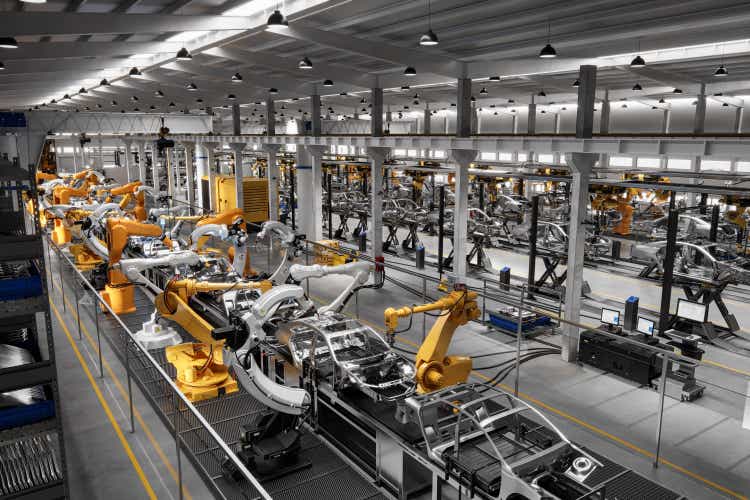alvarez/E+ via Getty Images
Shares of Samsara Inc. (NYSE:IOT) have taken a real beating amidst the correction in technology and IPO names over the past half a year, as well as the market as a whole, of course. The company went public towards the end of last year, when we were still in a different market mantra of course.
Industrial Automation Play
Unlike many technology names which went public last year, Samsara is a real established business, positioned as an industrial automation play.
Samsara has a goal to increase the safety, efficiency and sustainability of the global operations which power the world. The company offers connected operations which include video-based safety, vehicle telematics, apps, equipment monitoring and site visibility, among others. With an AI and machine learning platform, Samsara provides workflow solutions, analytics, alerts, APIs and security, among others.
The company was founded in 2015 and has rapidly grown the size and scope of the operations, recognizing the huge opportunities to be grabbed here. Digital transformation has been very visible in consumer, mobile and enterprise market, but not yet in physical operations. The company provides these solutions to transportation, wholesale, construction, logistics, utilities, energy, education, and food & drink operations, among others. These industries are typically outdated and rely heavily on manual processes, while environmental compliance and need for energy efficiency are on the rise, making that the opportunities are very large.
The connected operations of Samsara capture data from current data silos, gathered by a sensor (if not yet available). Towards the end of the third quarter, the quarter ahead of the offering, the company had some 13,000 customers.
The company went public by selling 35 million shares at $23 per share in December of last year, and with just over half a billion shares outstanding, the company was valued at $16.5 billion if we account for a net cash position of a billion. This valuation was applied to a business with a mere $120 million in sales in the year which ended February 2020, on which a huge operating loss of $228 million was posted.
Revenues rose more than 100% to $250 million for the year ending February 2021, as losses narrowed a bit to $210 million. In the first nine months of the calendar year 2021, sales rose 74% to $302 million, as a $400 million revenue run rate translated into a huge 40 times sales multiple. That was a bit too simplistic as third quarter sales of $114 million already ran at a $450 million run rate which is a bit more comfortable, as the third quarter operating loss of $32 million marked huge improvements as well.
These sky-high valuations made me very cautious on the stock, yet I was very upbeat on the long-term potential of the company, given the application, commercial traction, and huge opportunities. I concluded to initiate a tiny position, but with shares trading in the $30s in the days following the offering, I no longer was involved with the shares.
What Now?
Since that point in time, shares have gradually come down and have trended lower, now trading at $10 and change, actually up a bit from the lows which were already set in May, with shares trading below the $10 mark at the time.
Early this year, the company posted its fourth quarter results as revenues were up 66% to just over $125 million, running at half a billion run rate, with annual recurring revenue trending at $558 million. Reported losses were huge because of the IPO and related stock-based compensation expenses as adjusted operating losses narrowed quite a bit.
The company guided for first quarter sales at a midpoint of $131 million and full year sales at a midpoint of $573 million, with full year non-GAAP losses seen around 22% of sales, all of which feels a bit soft if I must say.
First quarter sales were posted in June as the numbers looked quite reasonable. Sales were up 63% to $142 million and change, comfortably ahead of the guidance, as annual recurring revenues rose to $607 million. GAAP operating losses came in at $70 million and adjusted losses of $25 million were equal to just 18% of sales. The entire discrepancy between both earnings metrics stems from stock-based compensation expenses, which are real, as the question is what remains the new run rate for this expense going forward.
With 507 million shares now trading at $10 and change, the market value has shrunken to $5.3 billion, or around $4.5 billion if we factor in the current net cash position. Alongside the release of the results, the company upped the full year guidance, now seeing sales at a midpoint of $595 million. Interesting enough is that adjusted operating losses are set to narrow slightly to 20% of sales, actually higher than guided before, as this is still ahead of the stock-based compensation expense of course.
An Update
With a current $4.5 billion valuation, the valuation multiples have compressed a great deal, with the business now trading at 7-8 times annual recurring revenues. That in itself is quite compelling given the long-term positioning and plus 60% topline growth rate.
The issue is that of the margins. After some real progress on this front last year, adjusted operating losses are seen around 20%, but this is still ahead of stock-based compensation expenses, which are somewhat unknown as a realistic run rate, but only add to the losses reported here.
So while this is still a very interesting stock with long-term potential, we have to recognize the impact of the current market sentiment. Fortunately, the burn rate is manageable given the huge net cash balances, yet the degree of the losses is a bit underwhelming as well. Hence, I now am much more constructive, and as I regard the name as a bit more quality than most technology names, but am only willing to commit a small speculative position here.
